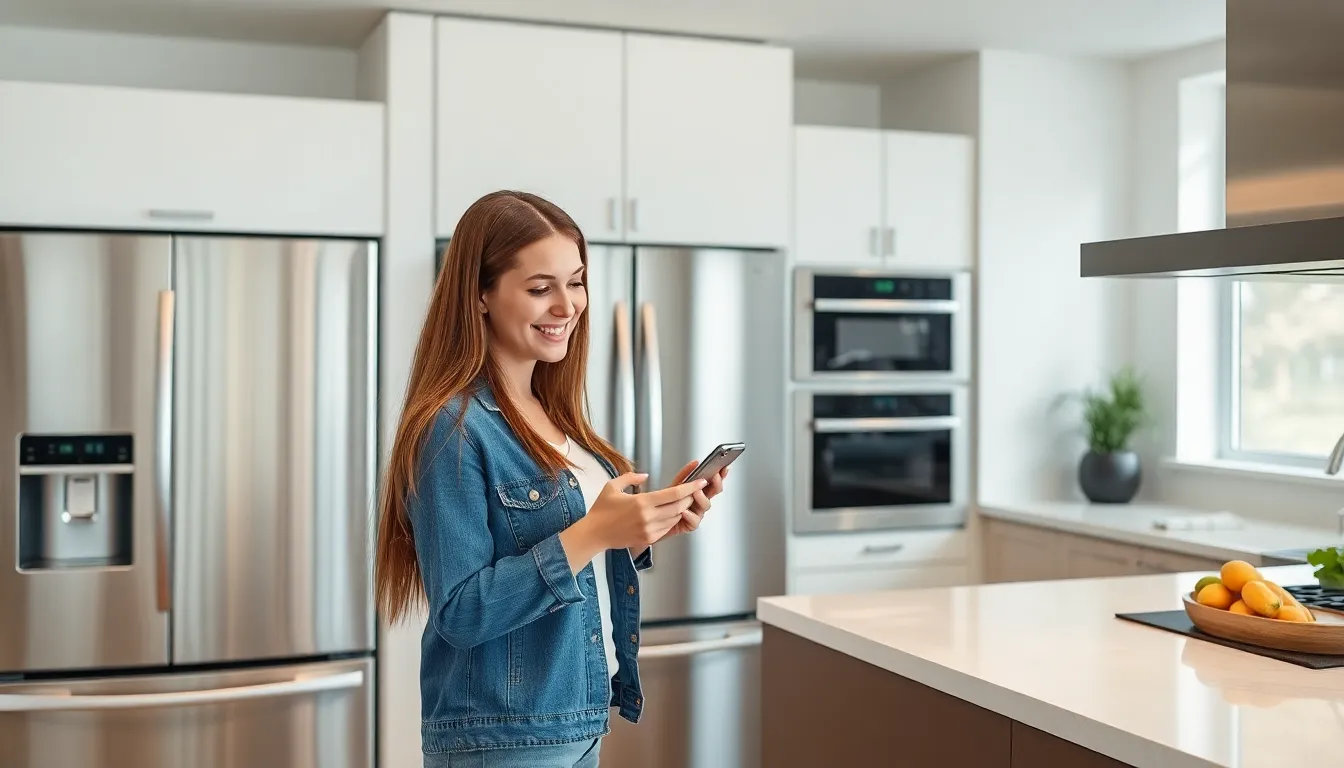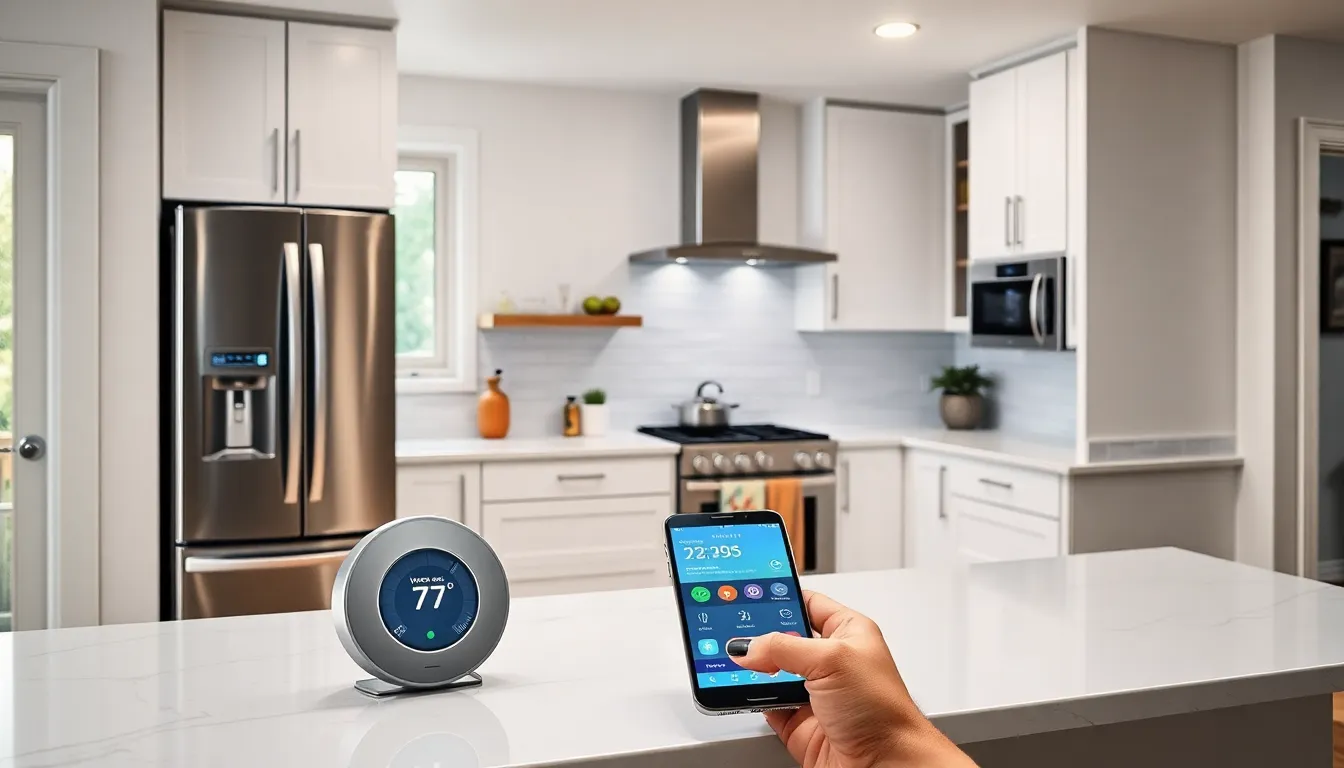In a world where even your toaster can be smarter than your average bear, smart appliance control is revolutionizing the way people manage their homes. Imagine telling your fridge to chill out while it organizes your groceries or having your coffee maker brew the perfect cup before you even roll out of bed. It’s like having a personal assistant who never complains about the hours!
As technology evolves, so does the way appliances interact with us. Smart appliances are no longer just a luxury; they’re becoming a necessity for the modern homeowner. With intuitive controls, voice commands, and even mobile apps, managing household tasks has never been easier—or more entertaining. So why not embrace this wave of innovation and let your gadgets do the heavy lifting? After all, who wouldn’t want to spend less time on chores and more time binge-watching their favorite shows?
Table of Contents
ToggleOverview Of Smart Appliance Control
Smart appliance control revolutionizes home management through interconnected devices. These appliances operate via voice commands and mobile applications, streamlining daily tasks. Users access their devices remotely, allowing for real-time monitoring and adjustments. Increased automation enhances user convenience, making routine chores less burdensome.
Smart appliances include refrigerators, ovens, washers, and thermostats, among others. Each device offers unique functionalities, such as energy monitoring and pre-programmed settings. For instance, smart ovens can be preheated remotely, enabling immediate cooking upon arrival home.
Connectivity plays a crucial role in smart appliance effectiveness. Wi-Fi or Bluetooth links connect devices with smartphones or smart home hubs. This integration allows users to group appliances under one application, enabling cohesive control.
User experience improves through personalized settings. Smart appliances learn preferences over time, adjusting performance to suit individual needs. Notifications provide useful updates, such as reminders for laundry cycles or low food supplies.
Data security remains a key concern. Manufacturers implement measures to protect user information, ensuring secure connections between devices. Regular software updates enhance security, addressing potential vulnerabilities.
Smart appliance control ultimately leads to energy savings. Efficient usage translates to reduced utility bills and lower carbon footprints. Embracing this technology not only simplifies home management but also contributes to a more sustainable lifestyle.
Benefits Of Smart Appliance Control
Smart appliance control offers significant advantages for modern homeowners. This technology enhances daily living, making tasks easier and more efficient.
Enhanced Convenience
Smart appliances simplify home management. Users can control devices through mobile apps or voice commands. Immediate access allows individuals to adjust settings from anywhere in the house. For example, adjusting the thermostat remotely ensures comfort upon arrival. Notifications about appliance status help individuals stay informed, preventing unexpected issues. Users appreciate features like scheduling and automation, which enable tasks to run at optimal times. The seamless integration of devices enhances the overall experience, allowing for effortless multitasking.
Energy Efficiency
Smart appliances promote energy efficiency. Many devices monitor consumption, providing insights into usage patterns. For instance, refrigerators and washers can optimize performance based on user habits. This optimization reduces energy waste, resulting in lower utility bills. By utilizing smart features, individuals can set timers or operate appliances during off-peak hours. Additionally, some smart appliances offer energy-saving modes designed to minimize power consumption. Implementing these features contributes to a lower carbon footprint, encouraging environmentally conscious habits.
Technology Behind Smart Appliance Control
Smart appliance control leverages advanced technology to enhance home management. This section explores key aspects like IoT integration and user interfaces.
IoT Integration
IoT, or the Internet of Things, connects smart appliances to the internet, enabling seamless communication. Devices communicate with each other, allowing users to control them through their smartphones or computers. Smart refrigerators can send alerts about expiration dates, while ovens can be preheated remotely. Compatibility across various platforms is vital for a cohesive ecosystem. Smart homes benefit from IoT integration by simplifying daily tasks and creating a more efficient living environment. The data exchanged enhances decision-making, as users gain insights into their appliance usage patterns.
User Interfaces
User interfaces play a crucial role in the effectiveness of smart appliance control. Intuitive designs help users navigate settings effortlessly. Voice commands via virtual assistants enhance accessibility. Mobile applications enable remote monitoring and operation of appliances from anywhere. Customizable dashboards allow users to see the status of multiple devices at a glance. Clear notifications provide updates on energy consumption and maintenance needs. Simple user interfaces that prioritize ease of use encourage widespread adoption. Prioritizing user experience ensures smart appliances fulfill their potential in simplifying home management.
Popular Smart Appliances
Smart appliances revolutionize home management, enhancing convenience and efficiency in daily tasks. Various devices seamlessly integrate into modern living environments.
Smart Refrigerators
Smart refrigerators offer advanced features that transform food storage. Users monitor contents remotely through mobile apps, receiving alerts when items are running low. These refrigerators often come with built-in cameras that provide a view inside without opening the door. Additionally, some models maintain optimal temperatures and humidity levels, extending food freshness. Energy-efficient settings contribute to reduced utility costs. Customizable storage options allow efficient organization. Integration with voice control systems provides hands-free access to recipes or shopping lists.
Smart Thermostats
Smart thermostats improve home heating and cooling efficiency. Homeowners program these devices to adapt to their schedules, reducing energy waste. Remote access through apps enables temperature adjustments from anywhere. Energy reports track usage patterns, offering insights into potential savings. Some models utilize machine learning to adjust settings automatically based on habits. Compatibility with other smart devices creates a cohesive home ecosystem. Notifications inform users about maintenance needs, ensuring systems operate effectively. Enhanced security features allow for geofencing, automatically adjusting settings when occupants leave or return.
Challenges In Smart Appliance Control
Despite the advantages of smart appliance control, several challenges persist that users must navigate.
Security Concerns
Smart appliances often collect personal data, raising privacy issues. Users may experience anxiety over data breaches that could expose sensitive information. Manufacturers combat these risks by implementing encryption and secure authentication methods. Regular software updates can enhance security features, but user vigilance is essential. Weak passwords and outdated firmware can create vulnerabilities, underscoring the importance of robust digital hygiene. Awareness of potential threats enables users to make informed choices about their smart devices.
Compatibility Issues
Compatibility among devices presents another significant challenge. Many smart appliances may not seamlessly integrate with each other or existing home automation systems. Some users encounter barriers due to varying communication protocols, such as Zigbee or Z-Wave. Choosing devices that support common standards can mitigate these issues. Additionally, software updates may be required for optimal functionality, making ongoing maintenance crucial. Users should consider compatibility when selecting appliances to ensure a cohesive smart home experience.
Conclusion
Smart appliance control is revolutionizing home management by offering unparalleled convenience and energy efficiency. As technology continues to advance, homeowners can expect even more innovative features that simplify daily tasks and enhance their lifestyles. Embracing these devices not only leads to a more connected home but also promotes sustainable living through energy savings.
While challenges like data security and compatibility exist, ongoing improvements in technology and manufacturer practices are addressing these concerns. By staying informed and choosing compatible devices, users can maximize their smart home experience. Ultimately, smart appliances represent a significant step toward a more efficient and enjoyable way of living.



